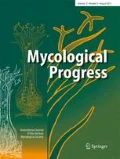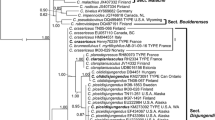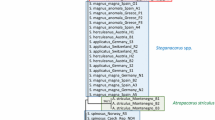Abstract
Amanita curtipes and A. ponderosa are two Mediterranean taxa sharing a number of morphological features as well as their habitat. Their synonymy or variety status has been proposed by several authors. To clarify this taxonomic issue we have sequenced the D1-D2 domains of the 28S rRNA gene as well as the complete ITS1-5.8S-ITS2 region of several specimens of the two species collected in Spain, and aligned these sequences with those from other Amanita species. Molecular phylogenetic analysis based on the two regions revealed that A. ponderosa and A. curtipes are clearly distinct species. The distribution of Amanita species in the phylogenetic trees was consistent with the division of the genus in subgenera and sections as proposed by previous authors. Sequences of A. ponderosa and A. curtipes were grouped in a monophyletic cluster together with other species of the section Amidella. However, A. ponderosa was closer to other species in the section, such as A. peckiana and A. volvata, than to A. curtipes. We also indicate the macromorphological characters that are most useful to reliably distinguish A. ponderosa and A. curtipes.




Similar content being viewed by others
References
Bas C (1969) Morphology and subdivision of Amanita and a monograph on its section Lepidella. Persoonia 5:285–579
Bridge PD, Roberts PJ, Spooner BM, Panchal G (2003) On the unreliability of published DNA sequences. New Phytol 160:43–48
Castro ML (1997) Analyse critique des taxons appartenant au groupe Amanita curtipes Gilbert (Agaricales, Basidiomycotina). Distribution dans la Peninsule Iberique. Doc Mycol 27:43–51
Courtecuisse R, Duhem B (1994) Guide des champignons de France et d’Europe. Delachaux et Niestlé, Lausanne
Daza A, Romero L, Santamaría C, Camacho M, Aguilar A, Megías M, Moreno G, Pérez M, Manjón JL (2002) El gurumelo, una seta de primavera. Quercus 193:20–24
Daza A, Moreno G, Santamaría C, Romero de la Osa L, Bernedo M, Manjón JL (2003) Amanita ponderosa “Gurumelo”, un hongo a estudiar por su interés gastronómico-silvícola en Andalucía (Sierra de Aracena), provincia de Huelva. Bol Soc Micol Madr 27:91–99
Drehmel D, Moncalvo JM, Vilgalys R (1999) Molecular phylogeny of Amanita based on large-subunit ribosomal DNA sequences: implications for taxonomy and character evolution. Mycologia 91:610–618
Gardes M, Bruns TD (1993) ITS primers with enhanced specifity for basidiomycetes. Aplication to the identification of mycorrhizae and rust. Mol Ecol 2:113–118
González V, Arenal F, Platas G, Esteve-Raventós F, Peláez F (2002) Molecular typing of Spanish species of Amanita by restriction analysis of the ITS region of the DNA. Mycol Res 106:903–910
Hall TA (1999) BioEdit: a user-friendly biological sequence alignment editor and analysis program for Windows 95/98/NT. Nucleic Acids Symp Ser 41:95–98
Hopple JS Jr, Vilgalys R (1994) Phylogenetic relationships among coprinoid taxa and allies based on data from restriction site mapping of nuclear rDNA. Mycologia 86:96–107
Konrad P, Maublanc A (1948) Les Agaricales vol 1. Encycl Mycol 14:1–464
Kühner R, Romagnesi H (1953) Flore analitique des champignons superieurs. Masson, Paris
Lim YW, Jung HS (1998) Phylogenetic relationships of Amanita species based on ITS1-5.8S rDNA-ITS2 region sequences. J Microbiol 36:203–207
Malençon G, Heim R (1942) Notes critiques sur quelques hymènomycetes d’Europe et d’Afrique du Nord I. Les amanites blanches meridionales. Bull Soc Mycol Fr 58:14–34
Mesplède VH (1980) Revision des Amanites. Bull Soc Mycol Bearn, num spec 50
Moncalvo JM, Drehmel D, Vilgalys R (2000) Variation in modes and rates of evolution in nuclear and mitochondrial ribosomal DNA in the mushroom genus Amanita (Agaricales, Basidiomycota): phylogenetic implications. Mol Phylogenet Evol 16:48–63
Moncalvo JM, Vilgalys R, Redhead SA, Johnson JE, James TY, Aime MC, Hofstetter V, Verduin SJW, Larsson E, Baroni TJ, Thorn RG, Jacobsson S, Clémençon H, Miller OK Jr (2002) One hundred and seventeen clades of euagarics. Mol Phylogenet Evol 23:357–400
Moreno G, Esteve-Raventós F (1988) Estudios micológicos en el Parque Natural de Monfragüe (Extremadura, España), I. Agaricales. Bol Soc Micol Madr 12:67–83
Nicholas KB, Nicholas HB Jr, Deerfield DW (1997) GeneDoc: Analysis and Visualization of Genetic Variation. EMBNEW NEWS 4:14
Nylander JAA (2004) MrModeltest v2. Evolutionary Biology Centre, Uppsala University
Oda T, Tanaka C, Tsuda M (1999) Molecular phylogeny of Japanese Amanita species based on nucleotide sequences of the internal transcribed spacer region of nuclear ribosomal DNA. Mycoscience 40:57–64
O’Donnell K (1993) Fusarium and its near relatives. In: Reynolds DR, Taylor JW (eds). The fungal holomorph: mitotic, meiotic and pleomorphic speciation in fungal systematics. CAB international, Wallingford, U.K., pp. 225–233
Peláez F, Platas G, Collado J, Díez MT (1996) Infraspecific variation in two species of aquatic hyphomycetes, assessed by RAPD analysis. Mycol Res 100:831–837
Pinho-Almeida F (1994) Estudos taxonómicos no género Amanita. Secçao Amidella- Complexo Lepiotoides: A. curtipes Gilbert, A. lepiotoides Barla e A. ponderosa Malençon & Heim. Rev Biol (Lisboa) 15:131–151
Posada D, Crandall KA (1998) Modeltest: testing the model of DNA substitution. Bioinformatics 14:817–818
Ronquist F, Huelsenbeck JP (2003) MrBayes 3: Bayesian phylogenetic inference under mixed models. Bioinformatics 19:1572–1574
Singer R (1986) The agaricales in modern taxonomy, 4th ed. Koeltz Scientific Books, Koenigstein, Germany, p 981
Swofford DL (2001) PAUP*: phylogenetic analysis using parsimony (and other methods). Version 4.0b10. Sinauer, Sunderland, Mass.
Thompson JD, Gibson TJ, Plewniak F, Jeanmougin F, Higgins DG (1997) The Clustal_X windows interface: flexible strategies for multiple sequence alignment aided by quality analysis tools. Nucleic Acids Res 25:4876–4882
Weiß M, Yang ZL, Oberwinkler F (1998) Molecular phylogenetic studies in the genus Amanita. Can J Bot 76:1170–1179
Yang ZL (1997) Die Amanita-Arten von Suedwestchina. Bibl Mycol 170:1–240
Zhang LF, Yang JB, Yang ZL (2004) Molecular phylogeny of eastern Asia species of Amanita (Agaricales, Basidiomycota): taxonomic and biogeographic implications. Fungal Divers 17:219–238
Acknowledgements
The authors would like to thank Dr. R. Korf for help with the English text. This study was made possible thanks to financial support from the Spanish Plan Nacional I+D of Research, projects 1FD97-1441 and SC00-081.
Author information
Authors and Affiliations
Corresponding author
Rights and permissions
About this article
Cite this article
Moreno, G., Platas, G., Peláez, F. et al. Molecular phylogenetic analysis shows that Amanita ponderosa and A. curtipes are distinct species. Mycol Progress 7, 41–47 (2008). https://doi.org/10.1007/s11557-007-0551-z
Received:
Revised:
Accepted:
Published:
Issue Date:
DOI: https://doi.org/10.1007/s11557-007-0551-z




